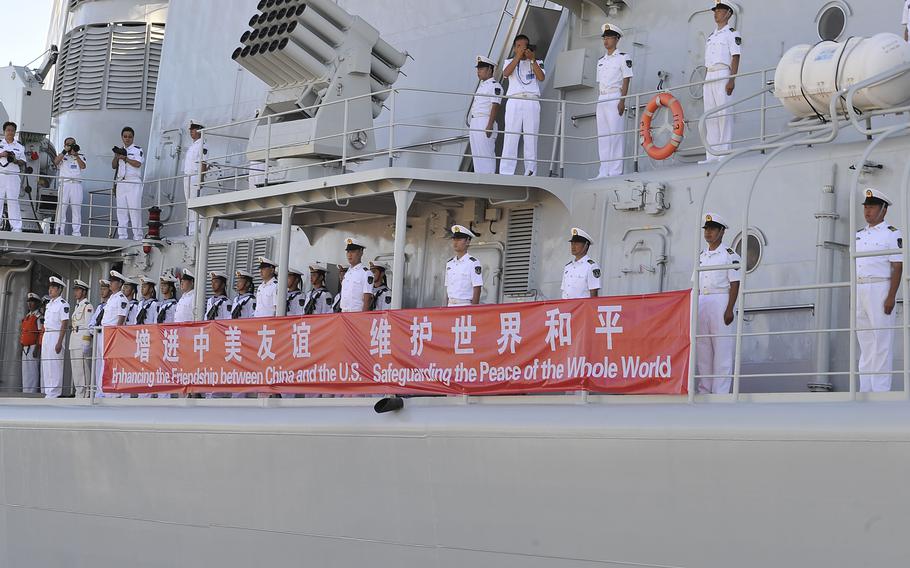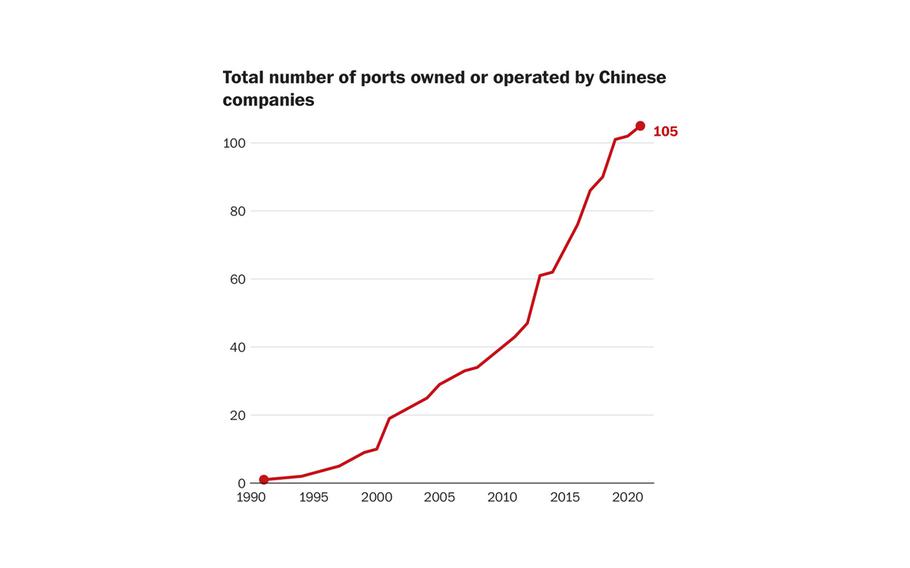
Crew members from China's People's Liberation Army-Navy Luhu-class destroyer Qingdao man the rails as it pulls into Joint Base Pearl Harbor-Hickam, Hawaii, Friday, Sept. 6, 2013. (Cynthia Clark/U.S. Navy)
A decade ago, Chinese President Xi Jinping launched the Maritime Silk Road, the oceanic component of his flagship Belt and Road Initiative aimed at improving China’s access to world markets by investing in transportation infrastructure. The initiative’s investments have since slowed as Chinese growth falters, the United States pushes back and countries question the indebtedness the projects brought.
But China has already secured a significant stake in a network of global ports that are central to world trade and freedom of navigation. Although the stated goal of the investments was commercial, the United States and its allies have grown increasingly concerned about the potential military implications.
Xi has frequently talked of his ambition to turn China into a “maritime superpower.” The port network offers a glimpse into the reach of those ambitions.
China’s ambitious sea route runs south from the coast of China through the major transit route of the Indian Ocean and the busiest maritime choke points of the Middle East, ending up in Europe.
When Xi announced his plan, China had stakes in 44 ports globally, providing a foundation for his strategy. A decade later, China owns or operates ports and terminals at nearly 100 locations in over 50 countries, spanning every ocean and every continent. Many are located along some of the world’s most strategic waterways.
The majority of the investments have been made by companies owned by the Chinese government, effectively making Beijing and the Chinese Communist Party the biggest operator of the ports that lie at the heart of global supply chains.
The expansion is critical to China’s economic power and has significant military implications as well, analysts say. “This is not coincidental,” said Carol Evans, director of the Strategic Studies Institute of the U.S. Army War College. “I firmly believe there is a strategic aspect to the particular ports they’re targeting for investment.”

The total number of ports owned or operated by Chinese companies. (The Washington Post)
The stated aim of this maritime network is commercial: to enhance and streamline China’s access to worldwide markets. In 2018, China expanded its maritime footprint at the Khalifa port in the United Arab Emirates, an important connector between Asia, Africa, Europe and the Middle East. Chinese state-owned Cosco Shipping built a commercial container terminal at the port, which it now operates.
But the investments go beyond that. They give Beijing a window into the business dealings of competitors and could be used to help China defend its supply routes, spy on U.S. military movements and potentially engage U.S. shipping, according to analysts. Chinese-owned ports or terminals are already ports of call for Chinese warships, such as the flotilla that entered the Nigerian port of Lagos in July.
In late 2015, China acknowledged it was building a military base adjacent to the Chinese-operated port of Djibouti. The African base was officially opened in 2017, only six miles away from a U.S. military base in the country. Located at the narrow entrance to the Red Sea, Djibouti is on one of the busiest shipping lanes in the world, where about 10 percent of global oil exports and 20 percent of commercial goods pass through the narrow strait to and from the Suez Canal.
Beijing is decades away from matching the U.S. military presence worldwide, but China has the biggest and fastest-growing navy in the world, and increasingly it is venturing beyond the shores of eastern Asia. From having no naval presence in the Indian Ocean two decades ago, for instance, China now maintains six to eight warships in the region at any given time, U.S. officials say.
A journey along the Maritime Silk Road illustrates some of the strategic advantages of China’s port investments.
Indian Ocean
A route for some major shipping lanes and global ports, the Indian Ocean was an early priority for China. About 80 percent of China’s trade crosses the ocean, including almost all of its oil. China’s port investments seem designed to protect the route. Beijing, for instance, has secured a 99-year lease at the port of Hambantota in Sri Lanka, giving it an important foothold on the busy shipping lane between Asia and the West.
Persian Gulf and Red Sea
China’s interest in these port locations goes beyond purely commercial concerns, U.S. officials say. Many are located at strategic chokepoints with high shipping traffic. At these locations, sea routes are narrow and ships are potentially vulnerable.
Strait of Hormuz
Leaked U.S. intelligence documents earlier this year suggested that China has revived an effort to establish military facilities at the United Arab Emirates port of Khalifa in the Persian Gulf, by the crucial Strait of Hormuz and just 50 miles away from an important U.S. military base.
Djibouti
China has already established one military facility adjoining a commercial port operation, in Djibouti, at the mouth of the Red Sea. U.S. officials say there are indications that it is scouting for more.
Suez Canal
Beijing has also been growing its influence in ports on Egypt’s Suez Canal, a vital human-built waterway that provides a shortcut from Asia to Europe. Earlier this year, Chinese shipping companies announced investments in terminals at the ports of Ain Sokhna and Alexandria.
Europe
China already controls or has major investments in more than 20 European ports, giving it significant sway over the continent’s supply routes. Many serve as vital logistics and transshipment points for NATO and the U.S. Navy. “It’s a significant national and economic security concern,” said Michael Wessel of the U.S.-China Economic and Security Review Commission.
Logink ports
One way in which China has secured a commanding position is through a little-known software system called Logink, a digital logistics platform owned by the Chinese government. It potentially gives China access to vast quantities of normally proprietary information on the movements, management and pricing of goods moving around the world. So far, at least 24 ports worldwide, including Rotterdam and Hamburg, have adopted the Logink system. The U.S. Transportation Department issued an advisory in August warning U.S. companies and agencies to avoid interacting with the system because of the risk of espionage and cyberattack.
The Americas
The original Maritime Silk Road, as laid out in Chinese documents, focused on three main routes. The plan has expanded to include the Atlantic and the Americas. Latin America is one of the fastest-growing destinations for Chinese port investments. China manages ports at both ends of the Panama Canal. It is building from scratch a $3 billion megaport at Chancay in Peru that will transform trade between China and Latin America, enabling the world’s largest shipping containers to dock on the continent for the first time.
The United States is still the world’s biggest military power, with about 750 bases overseas. China, with only one, is a long way from matching U.S. naval power, said Stephen Watts of the Rand Corp. “The implications of these far-flung bases have been overblown,” he said. “China would be easily overcome in these small outposts if it came to a shooting match.”
But China’s port network presents a different kind of challenge to U.S. security interests, separate from the threat of war, said Isaac Kardon of the Carnegie Endowment for International Peace. China is now the world’s premier commercial maritime power, and its strategic hold over the world’s supply routes could be used to interdict or restrict U.S. trade, troop movements and freedom of navigation in a range of different ways. “It’s an asymmetrical threat,” he said.